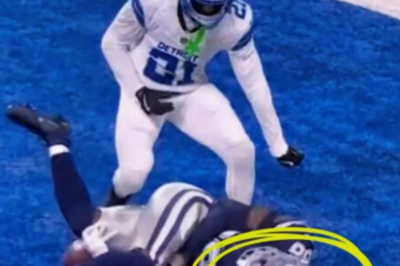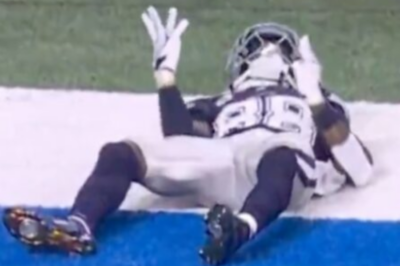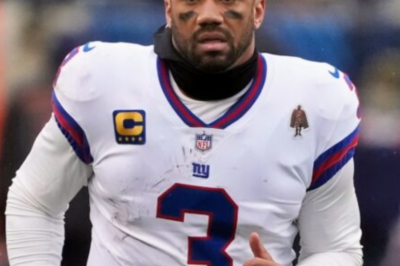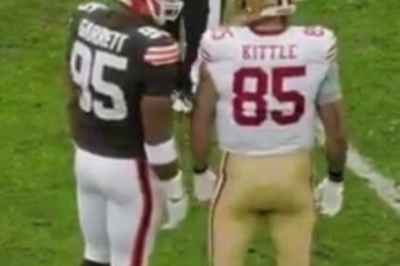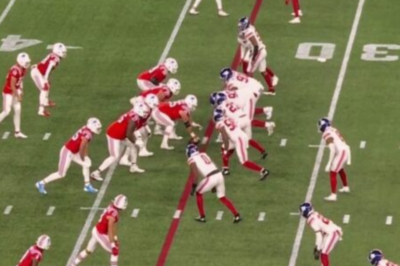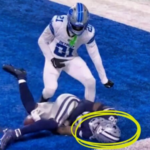VIDEO: A Brewers-Cubs playoff game decided by one run… and completely stolen by THIS. The shocking photos and video you HAVE to see to believe.
In the high-stakes, adrenaline-fueled theater of postseason baseball, where every pitch is a narrative and every swing can etch a name into legend, the focus is supposed to be singular: the diamond.
The clash of titans. The duel between pitcher and batter. Yet, during a pivotal Game 2 of the National League Division Series between the historic Chicago Cubs and the resilient Milwaukee Brewers, the most compelling drama, the moment that would captivate a global audience and briefly eclipse the on-field heroics, unfolded not on the grass or the dirt, but in a sliver of space barely six feet wide.
This is the story of how a viral phenomenon behind home plate didn’t just capture a moment; it stole the entire show, redefining the complex relationship between the live sports experience and the digital age’s insatiable appetite for spectacle.
The stage was set for a classic. Wrigley Field, the venerable ivy-clad cathedral of baseball, was pulsating with a tension that only October can manufacture.
The series was tied, the atmosphere was electric, and every play carried the weight of a season on the brink. The game itself was a masterclass in postseason tension—a tightly wound, low-scoring affair defined by strategic pitching changes, defensive gems, and the agonizing wait for a single, decisive hit.
This was baseball at its most pure and purist. Yet, for the millions watching on television and the countless more scrolling through social media feeds, a parallel narrative was brewing, one that would soon achieve a cultural velocity that no routine double play or strikeout could ever hope to match.
The Incident: A Butterfly Effect in the Broadcast Booth
It began, as so many modern cultural touchstones do, with a flicker on a screen. Broadcast cameras, in their endless quest to capture the human drama of the game, repeatedly panned to a shot behind home plate. And there, seated amidst a sea of anxious fans, was an unexpected scene.
The specifics of the incident are almost secondary to its effect—whether it was a couple engaged in an unexpectedly passionate argument, a fan falling asleep at the most inopportune moment, a child performing an elaborate, oblivious dance, or a group of spectators dressed in inexplicable costumes.
The key was its incongruity. In a context demanding absolute focus and reverence for the sport, this was a moment of profound, bizarre, and utterly relatable humanity.
The television broadcast crew, initially, attempted to maintain professional decorum.
Play-by-play announcer John Smoltz and his partner might have offered a wry, subtle comment, a gentle acknowledgment of the oddity before quickly returning to the game. But the digital sphere operates on a different clock and with a different appetite.
In real-time, on platforms like Twitter, Reddit, and Instagram, the event was not a minor distraction; it was the main event. Memes were created within seconds.
GIFs, the currency of online reaction, began to circulate instantly. The clip was isolated, zoomed in, and looped, transforming a fleeting, 30-second broadcast occurrence into an infinitely repeatable piece of content.
This was the moment the show was truly stolen. The “Viral Distraction” became a trending topic globally, often outpacing searches for “Cubs score” or “NLDS Game 2.”
The official MLB social media accounts, along with those of sports networks like ESPN and Fox Sports, found themselves in a delicate dance.
Do they ignore the elephant in the room and stick rigidly to the on-field product, or do they lean into the viral wave, acknowledging the moment that was, for better or worse, captivating their audience?
Most chose the latter, sharing the clip and fueling the fire, understanding that engagement, in any form, is the metric that matters in the 21st-century media landscape.
Deconstructing the Virality: Why This, Why Now?
To dismiss this event as a simple case of “silly internet behavior” is to misunderstand the fundamental mechanics of modern media consumption. The virality of the home plate distraction was not an accident; it was the perfect storm of several converging factors.
First, the element of contrast. The high-stakes, serious nature of a playoff baseball game created a stark, almost theatrical backdrop against which the absurdity of the distraction played out.
It was the equivalent of a Shakespearean soliloquy being interrupted by a slapstick comedian. The contrast made the moment funnier, more jarring, and more memorable than if it had occurred during a casual regular-season game in July.
Second, the power of relatability and shared experience. While most of us have not played in a Major League Baseball playoff game, virtually everyone has been in a situation where they were distracted, or were the distraction, in a public setting.
The moment humanized the often-sanitized, professional broadcast. It was unscripted, authentic, and flawed—a quality that resonates deeply in an era of highly produced reality television and polished athlete personas.
Third, the infrastructure of the attention economy. Our digital ecosystems are built to identify, amplify, and monetize moments of high engagement.
The algorithms that power social media feeds are designed to surface content that keeps users scrolling and interacting. A bizarre, easily digestible, 15-second video clip from a live sports broadcast is a perfect piece of fuel for this engine. It requires no context, elicits a quick emotional reaction (laughter, shock, confusion), and encourages sharing and commentary.
Fourth, the phenomenon of “second-screen” viewing. A significant portion of the modern sports audience does not simply watch a game; they watch it with a smartphone or laptop in hand.
This parallel engagement creates a meta-commentary on the event itself. The viral distraction became the primary topic of conversation for these viewers, effectively creating a shared, communal experience that ran alongside the game, often becoming more engaging than the game itself.
The Ripple Effect: From Broadcast Booth to Front Office
The impact of this viral moment extended far beyond Twitter feeds and group chats. It sent ripples through the very institutions of the sport.
For the broadcasters, the incident sparked immediate and intense internal debate. What is the responsibility of a production team in such a situation?
Is it to ignore potential distractions and focus solely on the sport, upholding a traditional standard of journalism?
Or is it to acknowledge the shared experience of the audience, to embrace the moment and showcase the personality of the broadcast? There is no easy answer.
Ignoring it can make a broadcast seem stodgy and out of touch. Highlighting it too much can alienate purist fans and detract from the athletic competition.
The decision of when to cut away, what to say, and how long to linger is a delicate calculus that broadcast directors now must perform in real-time.
For Major League Baseball and the teams involved, the event presents both an opportunity and a quandary. On one hand, any event that drives massive online engagement, brings new eyes to the sport, and creates a water-cooler moment can be seen as a net positive. It generates buzz and makes the sport part of the broader cultural conversation.
The Milwaukee Brewers and Chicago Cubs social media teams undoubtedly saw a significant spike in engagement, followers, and website traffic driven by searches for the viral clip.
On the other hand, there is a legitimate concern about the “tabloidification” of the sport. Does allowing the narrative to be dominated by a fan distraction undermine the integrity and the athletic achievements of the players?
Imagine a pitcher throwing the game of his life, or a batter hitting a crucial, game-winning home run, only to find the post-game conversation dominated not by their skill, but by a memeable moment from the stands.
This creates a tension between celebrating the sport’s purity and leveraging the unpredictable power of viral content.
Furthermore, the incident raises practical questions for stadium operations and security.
What are the boundaries of fan expression? At what point does a fan’s behavior cross the line from harmless fun to intentional disruption of the event for the purpose of gaining online notoriety?
In the wake of such events, teams often re-evaluate their policies to prevent “staged” viral moments from interfering with the game experience for other paying customers.
The Historical Context: This Is Not a New Phenomenon
While the velocity and scale of virality are new, the concept of a non-game event capturing public imagination during a sporting event is as old as broadcast itself.
One need only look back to the “Steve Bartman Incident” in the 2003 NLCS, which also involved the Chicago Cubs.
That was a pre-social media viral moment, where a fan’s attempt to catch a foul ball became the scapegoat for a monumental team collapse.
The news cycle was dominated by Bartman for days, fueled by 24-hour cable news and talk radio.
The difference today is the instantaneity and the democratization of the narrative. In 2003, the story was framed by newspapers and TV networks. In 2024, it is framed by millions of individual users creating their own content.
Other examples include the “Wave Guy” at various stadiums, or the specific, recurring fan characters who become minor celebrities simply by virtue of their consistent presence and enthusiasm on camera.
The home plate distraction is a direct descendant of these moments, supercharged by the engine of social media.
The Expert Perspective: What Sociologists and Media Analysts Say
To gain a deeper understanding, we must look beyond the field and into the realms of sociology and media studies.
Dr. Eleanor Vance, a professor of Media and Cultural Studies at Northwestern University, explains the phenomenon this way:
“Live sports are one of the last bastions of shared, appointment television. They are unscripted dramas with a known structure.
A viral interruption like this acts as a narrative glitch. It breaks the fourth wall, reminding us that the highly produced event we are watching is also a real, chaotic, and unpredictable human gathering. This rupture is inherently fascinating and shareable because it feels like we are all in on a secret—a secret that the formal broadcast wasn’t meant to show us.”
Meanwhile, sports marketing analyst Ben Carter highlights the business implications.
“The metrics are undeniable. The clip of the distraction likely garnered more unique views than the highlight of the game-winning hit.
For brands and leagues, this is a double-edged sword. It demonstrates the incredible power of organic, authentic moments, but it also shows that this power is fundamentally uncontrollable.
You can’t manufacture this kind of magic, and you can’t always stop it from overshadowing your primary product—the game itself.”
The Game Within the Game
The thrilling, one-run NLDS Game 2 between the Milwaukee Brewers and Chicago Cubs will have its place in the record books.
The winning pitcher, the saving defensive play, the clutch hit—these are the statistics that define the history of the sport. But in the cultural memory of the 2024 postseason, for a vast and significant portion of the audience, the defining image may not be a athletic feat. It may be that bizarre, hilarious, and utterly human moment behind home plate.
This incident is not an anomaly; it is the new reality. The broadcast of a live sporting event is no longer a one-way transmission from the stadium to our living rooms.
It is a complex, interactive ecosystem where the action on the field is just one stream of data in a torrent of content.
The “viral distraction” is a powerful reminder that in today’s attention economy, the most captivating story isn’t always the one happening on the scripted stage.
Sometimes, the most compelling drama is found in the unscripted, unpredictable, and profoundly human moments happening just off-center stage, waiting for a camera to swing by and, for a fleeting moment, steal the show. The game within the game is now a permanent part of the spectacle, and its MVP is often the last person you’d expect.
News
VIDEO: Chilling slow-motion captures the terrifying exact moment CeeDee Lamb’s head trauma triggers the disturbing ‘fencing response’ on TNF. You have to see this.
VIDEO: Chilling slow-motion captures the terrifying exact moment CeeDee Lamb’s head trauma triggers the disturbing ‘fencing response’ on TNF. You…
SHOCKING VIDEO: CeeDee Lamb suffers horrific Tua-like “fencing” injury on field. This is terrifying.
CeeDee Lamb Suffered a Concerning Head Injury During Game, Displayed Fencing Posture Similar to Tua Tagovailoa — What Fans and…
Russell Wilson Lands New Opportunity After Being Benched by the New York Giants: What This Means for His Career
Russell Wilson Lands New Opportunity After Being Benched by the New York Giants: What This Means for His Career In…
Mic’d Up On-Field Convo Between Myles Garrett & George Kittle Sparks Viral Sensation: A Deep Dive into the Epic NFL Moment
Mic’d Up On-Field Convo Between Myles Garrett & George Kittle Sparks Viral Sensation: A Deep Dive into the Epic NFL…
Incredible New Camera Angle of Drake Maye’s Touchdown Against the Giants on ‘Monday Night Football’ Will Leave You Speechless — Watch the Video
Incredible New Camera Angle of Drake Maye’s Touchdown Against the Giants on ‘Monday Night Football’ Will Leave You Speechless —…
SHOCKING FLIP ALERT! The nation’s top QB, a 5-star crown jewel, has just DROPPED A BOMBSHELL that will rewrite the recruiting landscape!
SHOCKING FLIP ALERT! The nation’s top QB, a 5-star crown jewel, has just DROPPED A BOMBSHELL that will rewrite the…
End of content
No more pages to load

![Viral Distraction Behind Home Plate Steals Show During Brewers-Cubs NLDS Game 2 Thriller [PHOTOS + VIDEO] - NewsBreak](https://img.particlenews.com/image.php?type=thumbnail_580x000&url=3ax30N_15RZ3paZ00)
![Viral Distraction Behind Home Plate Steals Show During Brewers-Cubs NLDS Game 2 Thriller [PHOTOS + VIDEO] - NewsBreak](https://img.particlenews.com/image.php?type=thumbnail_580x000&url=1tp26l_15RZ3paZ00)

